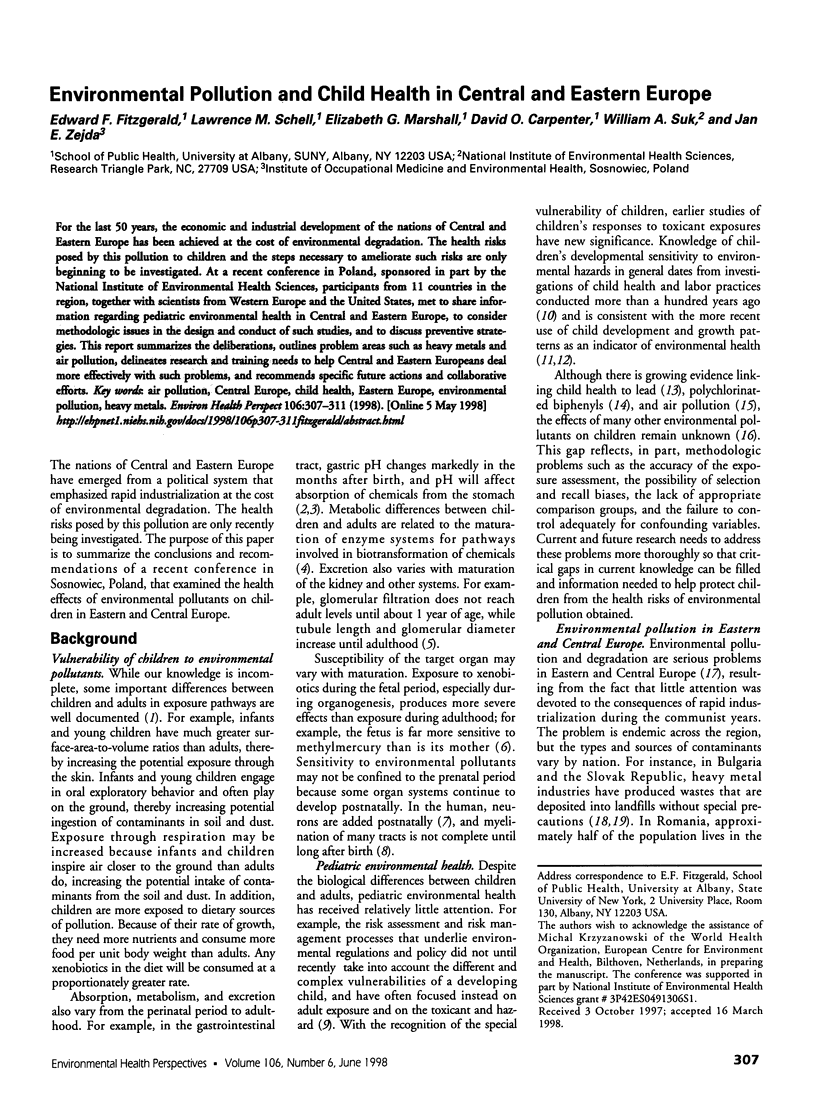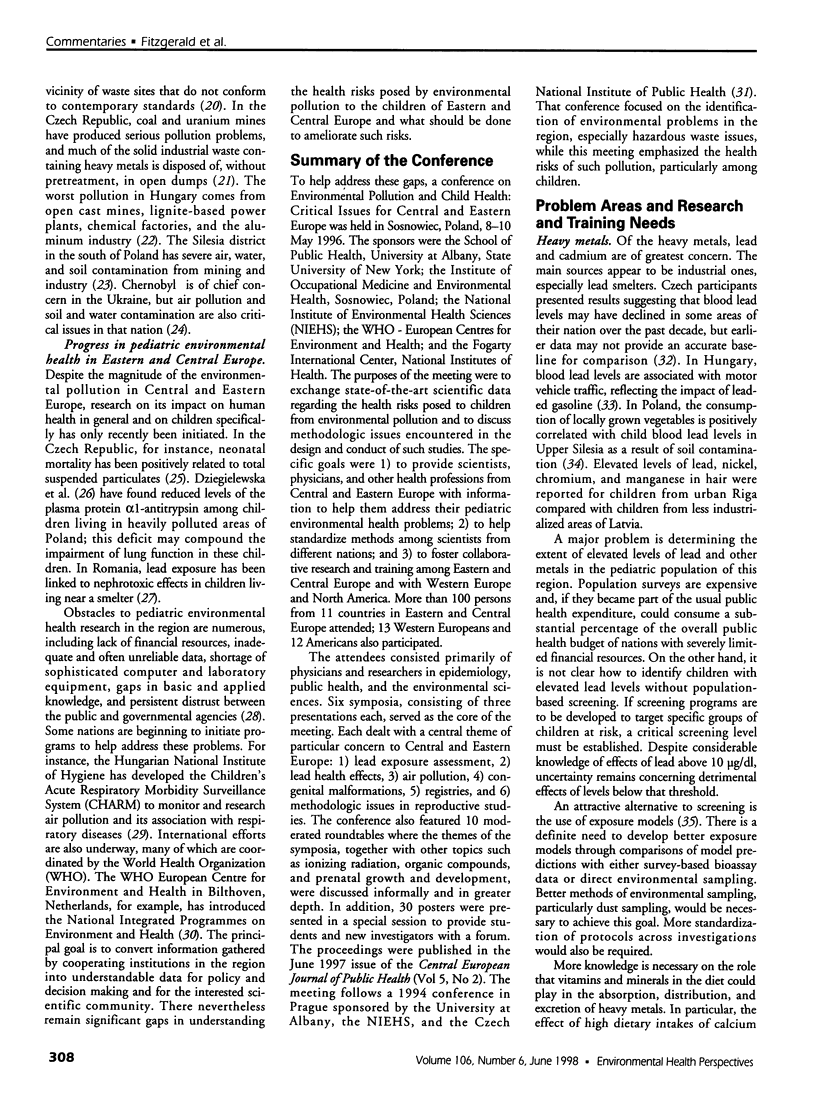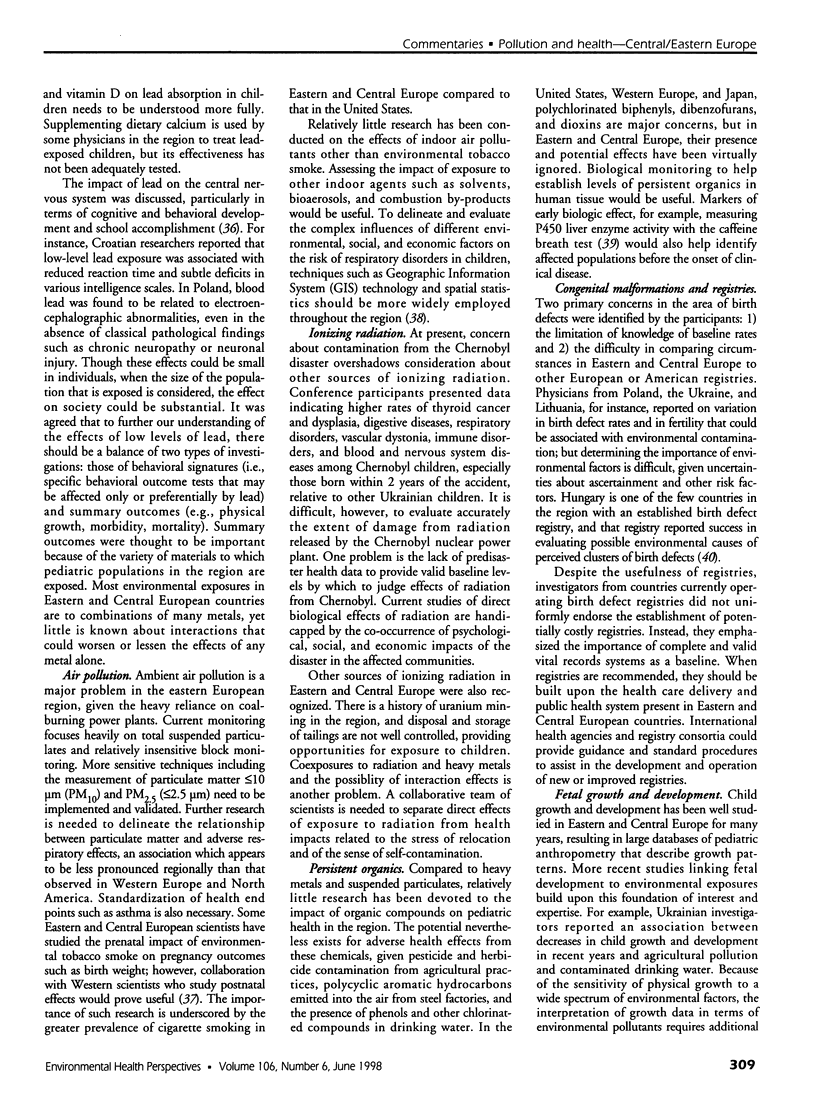Abstract
For the last 50 years, the economic and industrial development of the nations of Central and Eastern Europe has been achieved at the cost of environmental degradation. The health risks posed by this pollution to children and the steps necessary to ameliorate such risks are only beginning to be investigated. At a recent conference in Poland, sponsored in part by the National Institute of Environmental Health Sciences, participants from 11 countries in the region, together with scientists from Western Europe and the United States, met to share information regarding pediatric environmental health in Central and Eastern Europe, to consider methodologic issues in the design and conduct of such studies, and to discuss preventive strategies. This report summarizes the deliberations, outlines problem areas such as heavy metals and air pollution, delineates research and training needs to help Central and Eastern Europeans deal more effectively with such problems, and recommends specific future actions and collaborative efforts.
Full text
PDF




Selected References
These references are in PubMed. This may not be the complete list of references from this article.
- Agocs M. M., Rudnai P., Etzel R. A. Respiratory disease surveillance in Hungary. MMWR CDC Surveill Summ. 1992 Aug 28;41(4):1–8. [PubMed] [Google Scholar]
- Avdeev O., Korchagin P. Organization and implementation of contaminated waste neutralization in the Ukraine--National report. II. Cent Eur J Public Health. 1994;2 (Suppl):51–52. [PubMed] [Google Scholar]
- Bearer C. F. Environmental health hazards: how children are different from adults. Future Child. 1995 Summer-Fall;5(2):11–26. [PubMed] [Google Scholar]
- Bittó A., Horváth A., Sárkány E. Monitoring of blood lead levels in Hungary. Cent Eur J Public Health. 1997 Jun;5(2):75–78. [PubMed] [Google Scholar]
- Bobak M., Leon D. A. Air pollution and infant mortality in the Czech Republic, 1986-88. Lancet. 1992 Oct 24;340(8826):1010–1014. doi: 10.1016/0140-6736(92)93017-h. [DOI] [PubMed] [Google Scholar]
- Carpenter D. O., Suk W. A., Blaha K., Cikrt M. Hazardous wastes in Eastern and Central Europe [meeting report]. Environ Health Perspect. 1996 Mar;104(3):244–248. doi: 10.1289/ehp.96104244. [DOI] [PMC free article] [PubMed] [Google Scholar]
- Cikrt M., Smerhovsky Z., Blaha K., Nerudova J., Sediva V., Fornuskova H., Knotkova J., Roth Z., Kodl M., Fitzgerald E. Biological monitoring of child lead exposure in the Czech Republic. Environ Health Perspect. 1997 Apr;105(4):406–411. doi: 10.1289/ehp.97105406. [DOI] [PMC free article] [PubMed] [Google Scholar]
- Cucu M., Lupeanu M. I., Nicorici M., Ionescu L., Sandu S. The dangerous wastes and health risk in Romania--national report. Cent Eur J Public Health. 1994;2 (Suppl):41–42. [PubMed] [Google Scholar]
- Dziegielewska K. M., Guminska M., Matthews N., Saunders N. R., Wilkinson G. Reduced levels of alpha-1-antitrypsin in children exposed to high levels of air pollution. Biol Neonate. 1993;63(5):336–339. doi: 10.1159/000243950. [DOI] [PubMed] [Google Scholar]
- Etzel R. A. Active and passive smoking: hazards for children. Cent Eur J Public Health. 1997 Jun;5(2):54–56. [PubMed] [Google Scholar]
- Gilbert S. G., Grant-Webster K. S. Neurobehavioral effects of developmental methylmercury exposure. Environ Health Perspect. 1995 Sep;103 (Suppl 6):135–142. doi: 10.1289/ehp.95103s6135. [DOI] [PMC free article] [PubMed] [Google Scholar]
- Goldman L. R. Case studies of environmental risks to children. Future Child. 1995 Summer-Fall;5(2):27–33. [PubMed] [Google Scholar]
- Gzyl J. Assessment of Polish population exposure to lead and cadmium with special emphasis to the Katowice Province on the basis of metal concentrations in environmental compartments. Cent Eur J Public Health. 1997 Jun;5(2):93–96. [PubMed] [Google Scholar]
- Horváth A., Hegedüs E. Hazardous wastes in Hungary--national report. Cent Eur J Public Health. 1994;2 (Suppl):30–33. [PubMed] [Google Scholar]
- Jacobson J. L., Jacobson S. W. Intellectual impairment in children exposed to polychlorinated biphenyls in utero. N Engl J Med. 1996 Sep 12;335(11):783–789. doi: 10.1056/NEJM199609123351104. [DOI] [PubMed] [Google Scholar]
- Krześlak A., Korytkowski J. Hazardous wastes in Poland--national report. Cent Eur J Public Health. 1994;2 (Suppl):34–40. [PubMed] [Google Scholar]
- Lambert G. H., Kotake A. N., Schoeller D. The CO2 breath tests as monitors of the cytochrome P450 dependent mixed function monooxygenase system. Prog Clin Biol Res. 1983;135:119–145. [PubMed] [Google Scholar]
- Landrigan P. J., Carlson J. E. Environmental policy and children's health. Future Child. 1995 Summer-Fall;5(2):34–52. [PubMed] [Google Scholar]
- Lenková K., Vargová M. Hazardous wastes in the Slovak Republic--national report. Cent Eur J Public Health. 1994;2 (Suppl):43–48. [PubMed] [Google Scholar]
- Needleman H. L., Gatsonis C. A. Low-level lead exposure and the IQ of children. A meta-analysis of modern studies. JAMA. 1990 Feb 2;263(5):673–678. [PubMed] [Google Scholar]
- Pikhart H., Príkazský V., Bobák M., Kríz B., Celko M., Danová J., Pyrl K., Pretel J. Association between ambient air concentrations of nitrogen dioxide and respiratory symptoms in children in Prague, Czech Republic. Preliminary results from the Czech part of the SAVIAH Study. Small Area Variation in Air Pollution and Health. Cent Eur J Public Health. 1997 Jun;5(2):82–85. [PubMed] [Google Scholar]
- Rushbrook P. E. Regional health issues related to hazardous wastes. Cent Eur J Public Health. 1994;2 (Suppl):16–20. [PubMed] [Google Scholar]
- Siffel C., Czeizel A. E. Using the Hungarian Birth Defects Registry for surveillance, research and intervention. Cent Eur J Public Health. 1997 Jun;5(2):79–81. [PubMed] [Google Scholar]
- Spassov A. Identification of problems related to solid wastes in Bulgaria--national report. Cent Eur J Public Health. 1994;2 (Suppl):21–23. [PubMed] [Google Scholar]
- Verberk M. M., Willems T. E., Verplanke A. J., De Wolff F. A. Environmental lead and renal effects in children. Arch Environ Health. 1996 Jan-Feb;51(1):83–87. doi: 10.1080/00039896.1996.9935998. [DOI] [PubMed] [Google Scholar]
- Winneke G., Krämer U. Neurobehavioral aspects of lead neurotoxicity in children. Cent Eur J Public Health. 1997 Jun;5(2):65–69. [PubMed] [Google Scholar]
- Wyes H. W., Bláha K. The NIPEH network of cooperating countries of central and eastern Europe. National Integrated Programmes on Environment and Health. Cent Eur J Public Health. 1994 Dec;2(2):109–114. [PubMed] [Google Scholar]
- Zejda J. E., Grabecki J., Król B., Panasiuk Z., Jedrzejczak A., Jarkowski M. Blood lead levels in urban children of Katowice Voivodship, Poland: results of the population-based biomonitoring and surveillance program. Cent Eur J Public Health. 1997 Jun;5(2):60–64. [PubMed] [Google Scholar]


